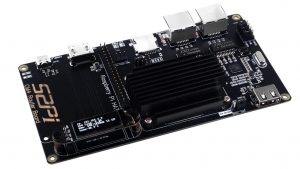I bought my 1st Raspberry Pi when the 1st version came out. I think my intention was to make a streaming music server out of it, which I did using logitechmediaserver. Logitechmediaserver is a MUCH CHEAPER implementation of Sonos. You’ve heard of Sonos, right? Ever since them I have used the Raspberry Pi for all sorts of things. Off the top of my head I can list:
- Music Server
- File Server with Samba
- Temperature and Humidity Platform (with added sensors)
- Hot Tub Hot Water Sensor and Alarm
- 433 MHz Weather Station
- Motion Cameras
- NAS Server with OpenMediaVault
- Dakboard (showing news feed, weather, calendar, etc)
- Police Scanner with OP25
- Streaming police scanner with IceCast
- Home Assistant for Home Automation
- Software Defined Radio Spyserver
- PiAware for tracking aircraft
- Satellite Tracking
- 3D printer server with Octoprint
- CNC G Code Sender
- Kodi Media Server
I bet you that I’m missing a whole lot of stuff too. That’s all I could think of quickly. But that’s a lot. Raspberry Pi variants have served me well over the years, helped teach me Linux, and is still a workhorse around my house.
So why would you get a Raspberry Pi in a Compute Module footprint? I’ll try to answer that.

First of all the Compute Module is made where the regular Raspberry Pi footprint won’t work. It is low profile and is really designed for people who design their own circuit boards for embedded solutions or robotics. Also a Compute Module with a pre-made carrier board can let you do some things a Raspberry Pi cannot do such as add higher speed (non USB) SATA ports or PCIe slots or add SSD NVME M.2 ports. That opens the doors quite a bit.
Or you can make a cluster of Pi’s and run Kubernetes. That’s a powerful build at a low cost and best of all a low power consumption device. There is one carrier board that will cluster 4 Pi’s together on an ITX form factor board and it pulls around 60 watts. But of course ………it’s not really available to buy yet.
So in theory (and practice) you could take a Carrier Board with SATA ports and make a NAS Server. Yeah it might be a little low powered but not everyone needs a Home Lab server to run Virtual Machines. Some of us just want to build a file server for backups and stuff. With a Compute Module and a lower cost Carrier board you could build a NAS pretty cheaply. One issue may be that it would be lacking a super cool, fit and finished enclosure, unless you can 3D print one up yourself. Otherwise your NAS Server might be a spaghetti mess laid out all over a table top.
Or you could build yourself a bad assed router with a Dual Gigabit Ethernet Carrier Board and OpenWRT. Another advantage to the Compute Module is the ability to change out the Pi with a faster version or one with more RAM in seconds and hardly miss a beat.
So I built a CM4 Pi with a Dual Gigabit Ethernet Carrier Board and put Pi OS on it and then stood back and realized not only wasn’t I gaining anything, I was losing stuff. Like 3 USB ports. I could put OpenWRT on it and build a specific router but if I DIDN’T want to do that I could just use a regular Pi 4. Unless I use this board as a router, it is just a crippled Pi, and at considerable cost compared to a Pi 4 or Pi Zero 2.

CM4 Router Board
I guess what I am saying is YOU KIND OF NEED A REASON OR SPECIFICALLY KNOW WHAT YOU ARE GOING TO DO WITH A COMPUTE MODULE. This is NOT a knock on the Compute Module as embedded applications are amazing and powerful.
SATA ports or a big SSD drive or several big SSD drives or clustering are a big advantage over a Pi 4 though. But again, I digress, unless you are doing something specific you might prefer staying with a regular Pi 4 or Pi Zero 2. MOST HOME HOBBYISTS ARE NOT GAINING MUCH BY CREEPING INTO THE COMPUTE MODULE WORLD.
Next, and this is big…………you just plain old can’t hardly find one of these awesome carrier boards. Then if you can………..you just plain old can’t find a Raspberry Pi Compute Module.
So while I’m dabbling with Compute Modules and TRYING to learn, the simple fact is that most hardware is unobtanium or vaporware due to the current global supply chain issues with processor and other various computer chips.
The only Compute Module that I could find that is actually available is the CM4102032 which has 32 GB of eMMC RAM onboard. I bought one and then rapidly found out you can’t just make an SD card and boot it up. You have to connect the Compute Module to another computer to flash the eMMC memory. It’s a little geeky and certainly doable but a whole new world to someone who has only used the standard Raspberry Pi with a removable SD card for a boot drive. It certainly left me scratching my head for a few minutes.
Conclusions:
- Compute Modules add power to Raspberry Pi users by offering a smaller form factor and the ability to add different computer interfaces and more hardware choices.
- This allows you to have a low wattage computer or cluster that sips power compared to more conventional computer builds.
- This in turn allows you to build experimental platforms that cost way less money than conventional computer builds.
- That is if you can find the hardware.
